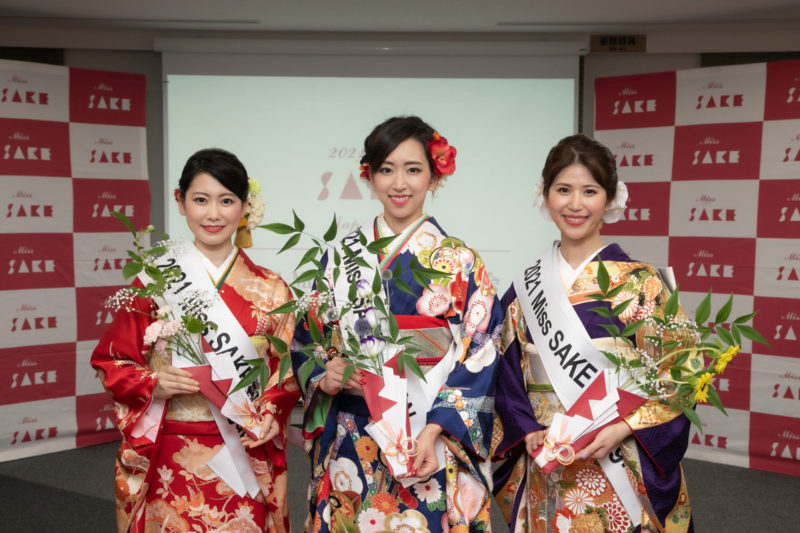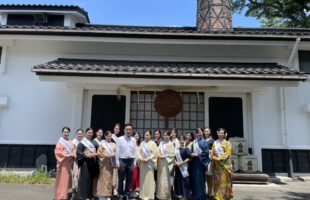今回のテーマは、『日本酒の造り方』。
日本酒は、数ある発酵食品の一つです。ビールやワインと同じ醸造酒ですが、日本酒は唯一並行複発酵方式により糖化と発酵を同時に進行させながら造られます。
この工程がとても複雑であり、また日本酒造りは麹菌や酵母菌など生き物を扱うとても繊細な工程があるため、主原料の米の品種、その特性ももちろん重要ですが、どのように酒造技術を生かすかということが品質に大きく影響すると言われており、長年の経験で培われたプロの技術・判断が求められます。
以下に、本日学んだ日本酒の造り方の日英対訳を記述させて頂きます。
英会話レッスンテーマ『日本酒の造り方 (How to Brew Japanese SAKE)』日英対訳
Unit 3. 日本酒の造り方
日本における日本酒造りは縄文時代後期に稲作を行っていることから、約2,000年の歴史があると考えられています。
最も古い日本酒は「口噛み酒」と呼ばれており、口の中で唾液に含まれる酵素が米を糖化させ、それを吐き出して野生酵母でアルコール発酵をさせるものでした。現代では、様々な機械を用い、一度に多くの酒を醸すことができます。
当時から現在にかけて、酒造りの技術や効率が格段に上がったことが分かります。日本酒造りは時代の変化とともに何度も変化を遂げ、大きく発展してきました。今回は、現在の日本酒の造り方を英語で表現する練習をさせて頂きました。
- 精米
日本酒造りは米の表面を削る精米から始まります。玄米の表面にはタンパク質や脂質が含まれ、これらが多いと雑味のある酒になるため、はじめに精米機を使用し精米します。精米後に残った米の割合を精米歩合といいます。
- 洗米・浸漬
精米直後のお米は糠に覆われています。これを取り除くことで米粒の内部にまで水分を浸透させ、次の工程である蒸米の準備をします。
- 蒸米
酒米を食用米と同じように炊くのではなく蒸す理由は、酒米を炊いてしまうと水分が多くなってしまうからです。蒸米することでお米を柔らかくするのです。この時、外が硬くなかが軟らかい状態が最も良いとされています。そうすることで、次の麹作りの工程において、水分を行き届かせるために米粒の深くまで浸透する、麹菌の働きを助けることができます。そして、約100度の温度で1時間ほど蒸します。
- 麹作り(製麹)
新しく蒸し上げられた酒米は、木製または金属製の壁でできた高温の麹室に運ばれます。そして蒸米に種麹を撒きます。約4日後、麹菌が全体に行き届き、麹が出来上がります。
- 酒母造り
小さなタンクに水・蒸米・麹を混ぜ合わせたものに酵母を加え、発酵に必要な酵母を培養させます。最近では、二週間ほどで酒母を造る速醸酛といわれる方法が最も一般的です。この酒母の出来が日本酒の香味に影響するためとても重要な工程になります。
- 醪作り
次に醪を作っていきます。水、蒸米、麹、酒母をタンクに入れます。醪作りには、三段仕込みといわれる方法が用いられます。これは4日間にわたり、酒母以外の3つの原料を3回に分けて投入します。一度に原料を入れてしまうと酒母の酸性度が下がってしまい雑菌繁殖の原因となりますが、3回に分けて投入することで酒母の酸性度を保つことができ、雑菌の繁殖を防ぐことができます。3回目の原料を投入してから、約20−25日間の月日をかけてこれらの原料が発酵し、酒の酛である醪が完成します。
- 上槽
醪が完成したら、液体と固体(酒粕)に分離する上槽を行います。上槽には様々な方法がありますが、最も代表的な搾り方はヤブタと呼ばれる自動圧搾濾過機を用いた方法です。圧縮後、蛇腹状の機械を広げ、酒粕を取り出します。この段階の生酒はアルコール度数がとても高く、まだ火入れはされていません。
- 濾過
上槽後、さらに残っている微細な粒子や雑味の成分、品質劣化の原因となる物質を濾過によって取り除きます。濾過の工程では、よく粉末状の活性炭が用いられます。活性炭には死んだ酵母や酵素、また残ったデンプンに含まれるとても小さな小片を吸着する隅や割れ目がたくさんあります。活性炭はお酒と混ぜ合わせられますが、特殊なフィルターを通すため、結果としてお酒は透き通った透明色になります。
9. 火入れ
上槽と濾過の過程を終えると、火入れの工程に入ります。日本酒を一気に65度くらいまで熱します。日本酒を加熱する目的は、酵素の働きを止め、残った細菌と酵母を殺すことで、常温貯蔵でも日本酒が腐らないようにするためです。火入れには幾つかの方法があります。1つ目は、プレートヒーター。日本酒を熱した配管に流し、その熱で日本酒を温めるという仕組みです。もう1つは、日本酒を詰めた瓶に熱湯をかける、または湯煎し、日本酒を温める方法です。
10. 貯蔵
出来上がった酒はタンクや瓶、カメで貯蔵されます。こうすることで、芳醇で滑らかな味わいになります。貯蔵期間は日本酒の種類によって異なりますが、たいていの場合、約3−6ヶ月ほど続きます。
11. 瓶詰め
最後に、日本酒が瓶詰めされます。この段階で、ほとんどの日本酒が再度火入れされ、仕込み水を加えてアルコール度数を15度前後にします。瓶に日本酒を詰め、蓋をします。瓶が冷え切ってからラベルを貼り、箱詰めされ出荷を待ちます。
【英訳】Unit 3. How to Brew Japanese SAKE
- Rice Polishing
The brewing process begins with polishing rice. It is to remove the outer layers of each grain exposing the starchy core. The surface contains protein and lipid a lot, and these cause unfavorable taste. So brewers polish the rice at first using a rice milling machine. The percentage to which the rice is milled is called “Seimaibuai”. This refers to the amount of rice remaining.
- Washing/Soaking
After the rice is milled, it is covered with rice flour, which is called ‘nuka’. In order to remove this flour and to begin introducing the moisture into the grain and preparing the rice for steaming, it is washed and soaked.
- Steaming
The reason why brewers steam rice is that if brewing rice is cooked the same as table rice, the brewing rice would be too watery. Brewers steam brewing rice to make it soft. The goal is to have each grain moist inside and dry on the outside. This encourages the Koji mold to dig deep into each grain to reach the moisture at the next process. Rice is then steamed at about 100 degrees for about 1 hour.
- Making Koji
Freshly steamed rice is moved to the Koji making room, which usually has either wood or metal walls and is quite hot. Steamed rice is the sprinkled with Koji mold spores. After about 4 days, the mold fully covers each grain and Koji rice has been created.
- Yeast Starter
In a small tank, water, steamed brewing rice, and Koji-rice are mixed together. Then brewers add yeast to it to grow the yeast needed for fermentation. These days, the Sokujo method is the most common. It takes about 2 weeks to create yeast starter. The quality of this yeast starter influences the flavor and taste of sake a lot.
- Brewing
Next is preparation of the main mash or “Moromi”. Water, rice, Koji-rice and the yeast starter are added to the main brewing tank. In a process known as san-dan-jikomi, three ingredients are added over the course of 4 days. This allows the yeast and Koji to adjust nicely between each addition without giving any room for unwanted microorganisms to grow. After the third addition of rice, water, rice, and Koji rice, the mash is left to ferment for additional 20-25 days.
- Pressing
Once the sake is done brewing, the newly created alcohol needs to be separated from the unfermented rice solids left in the mash. There are several methods for pressing sake, but the most common uses automatic pressing machine known as a Yabuta.After pressing, the frames of the machine can be opened and the sake kasu (sake lees) peeled out. The raw sake at this stage is full strength (usually around 18% alcohol at this point) and unpasteurized.
- Filtering
After pressing, any unprocessed matter is removed by filtration. This is often done by using charcoal powder. The charcoal bits have many nooks and crannies that trap the matter, dead yeast, enzymes or any tiny bits of remaining starch. The charcoal powder is mixed with the sake and then runs through a chambered filter lined with special filter paper. The resulting sake is clear and bright.
- Pasteurization
Once the sake is pressed and filtered, the next step is usually Pasteurization. This quickly heats the sake to around 65 degrees. The purpose of this heat is to deactivate enzymes and to kill of any remaining bacteria and yeast to make the sake shelf stable without refrigeration. There are several methods of Pasteurization. One method is running the sake through a heated pipe. Sake circulates in the pipe until the desired temperature is reached. Another method is to shower or submerge bottles with hot water.
10. Storage
Most sake are then stored in a tank underground at this stage. This allows the sake to mellow and develop a smoother flavor. Usually this lasts from 3-6 months.
11. Bottling
At last, sake is bottled. At this stage, sake is usually pasteurized again and water is added to bring the alcohol content to about 15%. Machines fill and seal the cap on each bottle. After the bottles have cooled down, they are labeled and boxed for shipping.
英語には無い「日本語・専門用語」を外国の方へ伝えるには?
今回のレッスンでの一番の気づきは、「相手の立場になり、補足しながら話す」ということです。
日本語の造り方を日本語で話す際は、専門用語で親しみがあまりない単語でも、漢字などから大体の意味が把握できますが、英語の場合は違います。日本酒を知っている海外の方で、その具体的な造り方や専門用語までを把握してる方は決して多くありません。
日本語で話す時のように一方的に日本酒造りの工程を英語で説明すると、専門用語が多いことから、海外の方にとっては内容についてくることが難しいと考えられます。
実際、レッスンの中で、インストラクターの方が戸惑いを見せる場面が多々ありました。それは、私が日本人の方に話す時と同じように、English Speakerに日本酒の造り方を説明していたからです。
理解度や知識量には個人差があり、ある方には理解してもらえた伝え方でも、別の方には同じ言い方でも伝わらないことがあります。
大切なことは、相手をよく理解し、その人に伝わる話し方をすること。これは決して難しいことではありませんが、日本語で話す時でさえ、誤解を招くような話し方をしてしまうことがあります。
難しいことや繊細な事柄を話す時には、「どのように説明すれば相手に理解してもらえるか」ということを意識し、簡単な単語を使ったり、時には補語を補いながら文章を構成する必要があります。
私のMiss SAKEの使命の一つに、言語の壁を超えて日本酒文化を伝えることが挙げられます。世界中のあらゆる地域、文化を持つ方にも日本酒の魅力をお伝えすることができますよう、今後も精進して取り組んで参りたいと思います。
次回のレッスンのテーマは、『日本酒の種類と区分』です。また多くのことを吸収できますよう、一生懸命励んでまいります。
Gaba様、この度は素晴らしいレッスンを誠にありがとうございました。
*他のレッスン様子は以下よりご覧いただけます。

英会話Gaba × Miss SAKE Miss SAKE(ミス日本酒)にご協力を頂いている企業様の中に、以前よりご協力いただいている「英会話のGaba」様がございます。 過去には英語を学びながら、ミス日本酒と日本酒を愉しむ「日本酒女子会 in English」も開催させていただいております...
英会話Gaba × Miss SAKE Miss SAKE(ミス日本酒)にご協力を頂いている企業様の中に、以前よりご協力いただいている「英会話のGaba」様がございます。 過去には英語を学びながら、ミス日本酒と日本酒を愉しむ「日本酒女子会 in English」も開催させていただいております...
The theme for this time was “How to Brew Japanese SAKE”
[for English Speakers]
The theme for this time was “How to Brew Japanese SAKE”. I learned how to explain the process to brew Japanese sake in English.
I described how to brew Japanese sake that I learned today below.
Unit 3. How to Brew Japanese SAKE
- Rice Polishing
The brewing process begins with polishing rice. It is to remove the outer layers of each grain exposing the starchy core. The surface contains protein and lipid a lot, and these cause unfavorable taste. So brewers polish the rice at first using a rice milling machine. The percentage to which the rice is milled is called “Seimaibuai”. This refers to the amount of rice remaining.
- Washing/Soaking
After the rice is milled, it is covered with rice flour, which is called ‘nuka’. In order to remove this flour and to begin introducing the moisture into the grain and preparing the rice for steaming, it is washed and soaked.
- Steaming
The reason why brewers steam rice is that if brewing rice is cooked the same as table rice, the brewing rice would be too watery. Brewers steam brewing rice to make it soft. The goal is to have each grain moist inside and dry on the outside. This encourages the Koji mold to dig deep into each grain to reach the moisture at the next process. Rice is then steamed at about 100 degrees for about 1 hour.
- Making Koji
Freshly steamed rice is moved to the Koji making room, which usually has either wood or metal walls and is quite hot. Steamed rice is the sprinkled with Koji mold spores. After about 4 days, the mold fully covers each grain and Koji rice has been created.
- Yeast Starter
In a small tank, water, steamed brewing rice, and Koji-rice are mixed together. Then brewers add yeast to it to grow the yeast needed for fermentation. These days, the Sokujo method is the most common. It takes about 2 weeks to create yeast starter. The quality of this yeast starter influences the flavor and taste of sake a lot.
- Brewing
Next is preparation of the main mash or “Moromi”. Water, rice, Koji-rice and the yeast starter are added to the main brewing tank. In a process known as san-dan-jikomi, three ingredients are added over the course of 4 days. This allows the yeast and Koji to adjust nicely between each addition without giving any room for unwanted microorganisms to grow. After the third addition of rice, water, rice, and Koji rice, the mash is left to ferment for additional 20-25 days.
- Pressing
Once the sake is done brewing, the newly created alcohol needs to be separated from the unfermented rice solids left in the mash. There are several methods for pressing sake, but the most common uses automatic pressing machine known as a Yabuta.After pressing, the frames of the machine can be opened and the sake kasu (sake lees) peeled out. The raw sake at this stage is full strength (usually around 18% alcohol at this point) and unpasteurized.
- Filtering
After pressing, any unprocessed matter is removed by filtration. This is often done by using charcoal powder. The charcoal bits have many nooks and crannies that trap the matter, dead yeast, enzymes or any tiny bits of remaining starch. The charcoal powder is mixed with the sake and then runs through a chambered filter lined with special filter paper. The resulting sake is clear and bright.
- Pasteurization
Once the sake is pressed and filtered, the next step is usually Pasteurization. This quickly heats the sake to around 65 degrees. The purpose of this heat is to deactivate enzymes and to kill of any remaining bacteria and yeast to make the sake shelf stable without refrigeration. There are several methods of Pasteurization. One method is running the sake through a heated pipe. Sake circulates in the pipe until the desired temperature is reached. Another method is to shower or submerge bottles with hot water.
10. Storage
Most sake are then stored in a tank underground at this stage. This allows the sake to mellow and develop a smoother flavor. Usually this lasts from 3-6 months.
11. Bottling
At last, sake is bottled. At this stage, sake is usually pasteurized again and water is added to bring the alcohol content to about 15%. Machines fill and seal the cap on each bottle. After the bottles have cooled down, they are labeled and boxed for shipping.
The theme for the next lesson is “The Classification of Japanese SAKE”.
I will work hard to absorb many things in the next lesson.
GABA, thank you very much for this wonderful lesson.
























